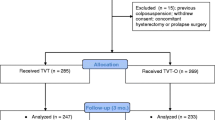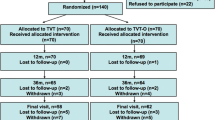Abstract
Purpose
To assess the long-term patient-reported outcomes following TO-TVT as a secondary continence procedure in women with recurrent stress urinary incontinence (R-SUI).
Methods
A secondary analysis of the 9-year follow-up of the E-TOT study was performed: 341 women with predominant SUI symptoms were randomised to undergo either Inside-out or Outside-in TO-TVT between April 2005 and April 2007. Forty-six women had R-SUI following previously failed continence surgery at time of randomisation and are the basis of this analysis as a one single cohort. Primary outcome was the patient-reported success rate defined as very/much improved on Patient’s Global Impression of Improvement (PGI-I). Secondary outcomes included late adverse events and impact on women’s quality of life and sexual function. Statistical analysis was performed using SPSS version 23.
Results
Sixty-three per cent completed the 9-year follow-up. The success based on the PGI-I was 62.1% with no significant difference between groups (OR 5.33; 95% CI 1.03, 27.76; p = 0.094). Clinically significant improvement in QoL was found in 84.2%. Adverse events included vaginal erosions (n = 3) and groin pain (n = 2). The small sample size is a limitation in this study; nevertheless, this is one of the largest cohorts reported for women with R-SUI and the first to report the long-term outcomes of TO-TVT as a secondary continence procedure.
Conclusions
TO-TVT operations are associated with good patient-reported success rates (62%) in women with previous failed continence surgery with up to 9-years follow-up. There is a non-significant trend towards better outcomes with the inside-out TO-TVT.


Similar content being viewed by others
References
Abdel-Fattah M, Familusi A, Fielding S, Ford J, Bhattacharya S (2011) Primary and repeat surgical treatment for female pelvic organ prolapse and incontinence in parous women in the UK: a register linkage study. BMJ Open 1:e000206
Denman MA, Gregory WT, Boyles SH, Smith V, Edwards SR, Clark AL (2008) Reoperation 10 years after surgically managed pelvic organ prolapse and urinary incontinence. Am J Obstet Gynecol 198:555.e1–555.e5
Fialkow M, Symons RG, Flum D (2008) Reoperation for urinary incontinence. Am J Obstet Gynecol 199:546.e1–546.e8
Agur W, Riad M, Secco S et al (2013) Surgical treatment of recurrent stress urinary incontinence in women: a systematic review and meta-analysis of randomised controlled trials. Eur Urol 64:323–336
Lovatsis D, Easton W, Wilkie D (2010) Society of obstetricians and gynaecologists of Canada urogynaecology committee. Guidelines for the evaluation and treatment of recurrent urinary incontinence following pelvic floor surgery. J Obstet Gynaecol Can 32:893–904
Nadeau G, Herschorn S (2014) Management of recurrent stress incontinence following a sling. Curr Urol Rep 15:427,014-0427-0
National Institute for Health and Clinical Excellence (NICE) (2013) Urinary incontinence: the management of urinary incontinence in women. CG171: https://www.nice.org.uk/guidance/cg171/chapter/1-Recommendations#surgical-approaches-for-sui-2
Ford AA, Rogerson L, Cody JD, Ogah J (2015) Mid-urethral sling operations for stress urinary incontinence in women. Cochrane Database Syst Rev 7:CD006375
Scientific Committee on Emerging and Newly Identified Health Risks (SCENIHR) (2015) Opinion on: the safety of surgical meshes used in urogynecological surgery 2015. http://ec.europa.eu/health/scientific_committees/consultations/public_consultations/scenihr_consultation_27_en.htm
Abdel-Fattah M, Ramsay I, Pringle S et al (2010) Randomised prospective single-blinded study comparing ‘inside-out’ versus ‘outside-in’ transobturator tapes in the management of urodynamic stress incontinence: 1-year outcomes from the E-TOT study. BJOG 117:870–878
Abdel-Fattah M, Mostafa A, Familusi A, Ramsay I, N’dow J (2012) Prospective randomised controlled trial of transobturator tapes in management of urodynamic stress incontinence in women: 3-year outcomes from the evaluation of transobturator tapes study. Eur Urol 62:843–851
Abdel-Fattah M, Ramsay I, Pringle S et al (2011) Evaluation of transobturator tension-free vaginal tapes in management of women with recurrent stress urinary incontinence. Urology 77:1070–1075
Delorme E (2001) Transobturator urethral suspension: mini-invasive procedure in the treatment of stress urinary incontinence in women. Prog Urol 11:1306–1313
de Leval J (2003) Novel surgical technique for the treatment of female stress urinary incontinence: transobturator vaginal tape inside-out. Eur Urol 44:724–730
Kelleher CJ, Cardozo LD, Khullar V, Salvatore S (1997) A new questionnaire to assess the quality of life of urinary incontinent women. Br J Obstet Gynaecol 104:1374–1379
Hiller L, Bradshaw HD, Radley SC, Radley S (2002) A scoring system for the assessment of bowel and lower urinary tract symptoms in women. BJOG 109:424–430
Rogers RG, Coates KW, Kammerer-Doak D, Khalsa S, Qualls C (2003) A short form of the Pelvic Organ Prolapse/Urinary Incontinence Sexual Questionnaire (PISQ-12). Int Urogynecol J Pelvic Floor Dysfunct 14:164–168
Yalcin I, Bump RC (2003) Validation of two global impression questionnaires for incontinence. Am J Obstet Gynecol 189:98–101
Avery K, Donovan J, Peters TJ, Shaw C, Gotoh M, Abrams P (2004) ICIQ: a brief and robust measure for evaluating the symptoms and impact of urinary incontinence. Neurourol Urodyn 23:322–330
Abdel-fattah M, Hasafa Z, Mostafa A (2011) Correlation of three validated questionnaires for assessment of outcomes following surgical treatment of stress urinary incontinence in women. Eur J Obstet Gynecol Reprod Biol 157:226–229
Karmakar D, Mostafa A, Abdel-fattah M (2016) Long-term patient-reported outcomes of transobturator tapes in women with stress urinary incontinence (Unpublished)
Bakali E, Buckley BS, Hilton P, Tincello DG (2013) Treatment of recurrent stress urinary incontinence after failed minimally invasive synthetic suburethral tape surgery in women. Cochrane Database Syst Rev 2:CD009407
Cartwright R, Brown H, Rizk D (2016) Patient reported outcome measures after incontinence and prolapse surgery: are the pictures painted by the ICIQ and PGI-I accurate? Int Urogynecol J 27:507–508
Nikolopoulos KI, Betschart C, Doumouchtsis SK (2015) The surgical management of recurrent stress urinary incontinence: a systematic review. Acta Obstet Gynecol Scand 94:568–576
Stav K, Dwyer PL, Rosamilia A et al (2010) Repeat synthetic mid urethral sling procedure for women with recurrent stress urinary incontinence. J Urol 183:241–246
Teo R, Moran P, Mayne C, Tincello D (2011) Randomized trial of tension-free vaginal tape and tension-free vaginal tape-obturator for urodynamic stress incontinence in women. J Urol 185:1350–1355
Zhang Z, Zhu L, Xu T, Lang J (2016) Retropubic tension-free vaginal tape and inside-out transobturator tape: a long-term randomized trial. Int Urogynecol J 27:103–111
Kelleher CJ, Pleil AM, Reese PR, Burgess SM, Brodish PH (2004) How much is enough and who says so? BJOG 111:605–612
Liapis A, Bakas P, Creatsas G (2009) Tension-free vaginal tape in the management of recurrent urodynamic stress incontinence after previous failed midurethral tape. Eur Urol 55:1450–1455
Acknowledgements
We thank Dr. Karmakar (Research Fellow—University of Aberdeen) for sending out the questionnaires and collating the responses. We thank Lindsey Grant for performing the independent data entry cross-check. A special gratitude goes to all the participants whose excellent cooperation over the years made this study successful.
Funding
The initial phase of this study (up to 3-year follow-up) was funded by the Henry Smith Charity. Dr. Karmakar was funded by IUGA Clinical Fellowship Grant 2014.
Authors’ contributions
For this long-term study, MAF and AM conceived the idea, obtained funding and secured the ethics and institutional approvals. AM and GC were involved in data collection. GC was involved in data entry and data analysis. AM and LG (trial coordinator) performed 100% cross-checking of the data entry. GC arranged review of the statistics analysis plan with the statistics clinic in University of Aberdeen. AM supervised the data analysis. GC and MAF wrote the manuscript. All authors critically reviewed the manuscript and approved it. All authors take full responsibility for the integrity of the study and the data presented.
Author information
Authors and Affiliations
Corresponding author
Ethics declarations
Conflict of interest
Dr. Abdel-Fattah has previously delivered paid lectures and/or training courses for Bard, Coloplast, AMS, Pfizer and Astellas. He received travel grants from different pharmaceutical companies to attend medical conferences in the past. University of Aberdeen received research grant from Coloplast in 2009. Dr Alyaa Mostafa received travel award from the International Continence Society (ICS) to attend the ICS annual conference in 2012. Gabriel Cao received a travel award from UKCS to attend the UKCS annual conference in 2016.
Ethical approval
The study timely received all required approvals from Research & Development Departments in Glasgow & Aberdeen and the relevant ethics committee WOSRES (Ref05/S0702/6) and was registered on www.clinicaltrials.gov (NCT00136071) in 2005.
Rights and permissions
About this article
Cite this article
Abdel-Fattah, M., Cao, G. & Mostafa, A. Long-term outcomes of transobturator tension-free vaginal tapes as secondary continence procedures. World J Urol 35, 1141–1148 (2017). https://doi.org/10.1007/s00345-016-1969-1
Received:
Accepted:
Published:
Issue Date:
DOI: https://doi.org/10.1007/s00345-016-1969-1




